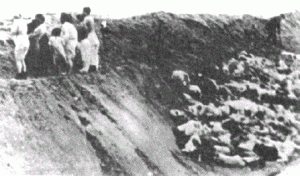The announcement read: “All Jews living in the city of Kiev and its vicinity must come to the corner of Melnikova and Dokhturovska Street by 8 o’clock on the morning of Monday, September 29th 1941. They are to bring with them documents, money, valuables, as well as warm clothes, underwear etc. Any Jews not carrying out this instruction and who are found elsewhere will be shot. Any civilian entering apartments left by the Jews and stealing property will be shot.” By nightfall of the following day, 33,771 Jews of Kiev had been massacred: machine gunned to death by Adolf Hitler’s elite Waffen SS troops; their victims’ naked corpses transforming the picturesque ravine of Babi Yar into a bloody, unconsecrated grave.
The Babi Yar Massacre was to be the Nazis largest single mass killing. Yet Babi Yar’s gruesome atrocities soon came to be dwarfed in the proceeding war years by the Nazis’ introduction of heavy industry, in their effort to bring systematic method to their murderous activities. It is, however, only when we consider these atrocities in isolation that we can attempt to humanise the incomprehensible. From the gruesome evidence, and the testimony of the mere handful of survivors, this is what we know about the tragedy which happened seventy-two years ago today.
Some ten days earlier, Kiev had traded one oppressor for another when it was captured from Russia by Germany. Free from Stalin’s tyranny, some Ukrainians even dared to be optimistic – remembering similar circumstances during World War I when occupation by the Germans had been preferable to the Russians. But shortly after the takeover, several buildings occupied by the German military were blown up. After the war, it emerged that the NKVD – the Soviet Security Police – had been responsible for the bombings. But the Germans concluded it must have been the work of Jews – and, on September 26th, they held a meeting during which it was decided that, in retaliation, all of the Jews of Kiev should be exterminated. Two days later, notices were posted throughout the city, demanding that all Jews assemble and implying that they would be resettled in new locations.
On the morning of September 29th, thousands of Jews reported to the appointed location where they were then marched in groups of 100 towards the Jewish cemetery near the Babi Yar ravine – the entire area ominously cordoned off with barbed wire. The Jews were then divided into groups of ten and led through a three-rowed corridor of troops made up of Ukrainian police, Waffen-SS and Sonderkommando until they reached an area of overgrown grass. There they were ordered to surrender their possessions, remove their clothes and proceed to the ravine edge – at which point they were shot, their bodies collapsing into the ravine.
A German commander would report that, “Because of ‘our special talent of organisation’, the Jews still believed to the very last moment before being murdered that indeed all that was happening was that they were being resettled.” But by the time the Jews heard the machinegun fire and realised what was happening, there was no chance of escape. They had no choice but to pass through the assembly line and towards their deaths.
The Germans had anticipated that only 5,000 Jews would assemble, and so the slaughter ended up taking two days; the executioners finally became so impatient that they put two people together head to head in order that one bullet would kill them both. The 33, 771 bodies were hastily covered with a thin layer of soil and then left until the summer of 1943, when 300 Jewish prisoners were forced to exhume and burn the corpses (which, by that time, numbered around 100,000 as Communists, Gypsies and prisoners of war had also been condemned to the same grisly fate) as the Nazis attempted to conceal their crimes.
A few miraculously managed to survive; buried alive amongst thousands, they clawed their way out through the earth and found hiding places. But it was not until the poet Yevgeny Yevtushenko memorialized the Kiev Jews in 1961 and then, five years later, survivor Anatoly Kuznetzov’s extraordinary account of the massacre – Babi Yar: A Document in the Form of a Novel – was published in the Soviet Union (who, themselves anti-Semites, had suppressed evidence in the years since their re-occupation of Kiev) that the world would learn what had occurred at Babi Yar.



One Response to 29th September 1941 – The Babi Yar Massacre